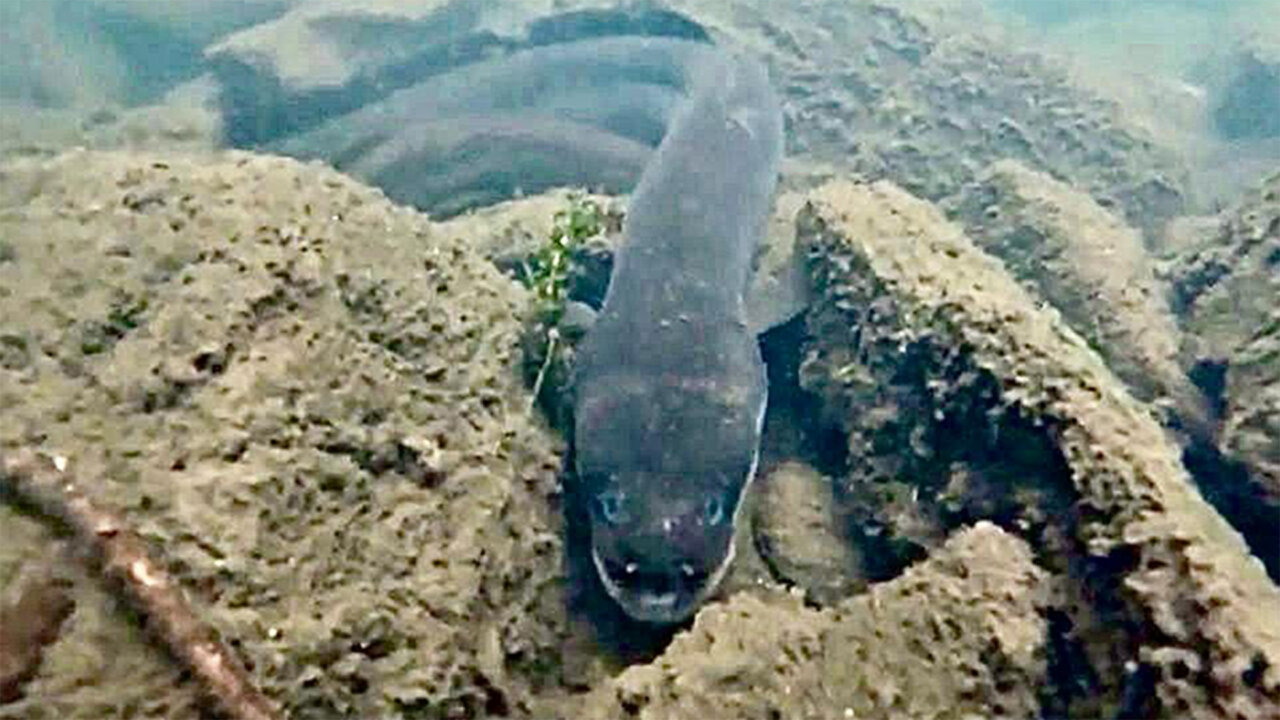
American Eel (Anguilla rostrata). Credit: ©Clinton & Charles Robertson from RAF Lakenheath, UK & San Marcos, TX, USA & UK, CC BY 2.0, via Wikimedia Commons
This week, governments from around the world have gathered in Samarkand, Uzbekistan, for the 20th meeting of the Convention on International Trade in Endangered Species of Wild Fauna and Flora—better known as CITES. Among the many proposals on the agenda is one that would place the American eel, and indeed all eels, under the treaty’s Appendix II protection to require that all trade be legal and sustainable.
For a species that connects the rivers of New York to the open Atlantic, this global decision feels very close to home.
At the Wildlife Conservation Society’s New York Aquarium, we’ve been watching the slow, secret lives of eels in the Bronx River for more than a decade. These fish are born far out in the Sargasso Sea, drift for months on ocean currents, then make their way into the rivers and streams of the Atlantic coast to grow. They are what scientists call catadromous—species that live most of their adult lives in freshwater or estuaries but return to the ocean to spawn. American eels spawn only once before they die.
That journey, upstream and back again, can span thousands of miles and decades of life. If a human were to walk an equivalent distance, it would take them around the globe more than 7 times, or a quarter of the way to the moon. It links freshwater and saltwater, continents and coasts—a reminder that what happens upstream can ripple all the way to the sea.
The Wildlife Conservation Society’s connection to this species goes back a full century. In 1925, the New York Zoological Society—as WCS was then known—sent the research vessel Arcturus on an ambitious scientific voyage led by Bronx Zoo naturalist William Beebe. The expedition covered nearly 14,000 miles in the Atlantic, gathering data on ocean life. Among the scientists aboard was marine biologist Dr. Marie Fish, whose research in the Sargasso Sea confirmed for the first time that American eels begin their lives there.

The New York Zoological Society’s Marie Fish, sorting sargasso weed, 1925. Credit: WCS Archives ©WCS
Her work stood out not only for what it revealed, but for who she was—a woman conducting groundbreaking marine research at a time when few women were given the chance to lead in science. Her eel studies were one discovery among many on that voyage, but they resolved a mystery that had puzzled naturalists for generations.
Today, you can still find eels in the Bronx River—slipping through shaded pools and beneath low bridges. Since 2012, our team has worked with students, community groups, and volunteers to study them. We’ve captured and released more than 1,600 eels and tagged over 500 with microchips to learn how dams on the Bronx River have affected their local population.
The patterns we see tell a clear story: eel numbers fall sharply at each dam, while individual size increases farther upstream. Larger eels tend to be female, and larger females produce more eggs when they spawn. These findings show how barriers fragment habitat, cutting fish off from the upper reaches of the river and reducing the reproductive potential of Bronx River eels. Our work will help guide dam removals and fish-passage projects that give these animals access to more developmental habitat..

American eel in the Bronx River. Credit: ©WCS
American eels are listed by the IUCN as Endangered, and they face pressures far beyond New York. Across their range—from Greenland to South America—the species has declined due to overfishing, habitat loss, pollution, and climate change. A booming market for young “glass eels” has added to the strain. These transparent juveniles can sell for thousands of dollars per pound in East Asia, feeding a global demand that too often skirts regulation, and illegal trade is a growing problem.
For a fish that takes decades to mature and spawns but once at the end of its life, the impact of this trade is enormous.
That is why WCS supports listing the American eel—and all Anguillid eel species—on CITES Appendix II to confront a major driver of exploitation, reinforce efforts to stop trafficking, and give space for science-based management to work. It would also complement local action: restoring freshwater habitat, removing outdated dams, and reopening migration routes from upstream areas back to the ocean.
Eels don’t attract the same attention as whales, turtles, or tigers. They move mostly at night, and most people never see one in the wild. Yet they have quietly tied together ecosystems and human cultures for centuries. They appear in the stories of Indigenous communities, in the notebooks of early naturalists, and in the daily work of conservationists trying to keep rivers alive. Their survival tells us something about our own—the health of the waterways that sustain them also sustains us.
As we mark the 100th anniversary of the Arcturus expedition, I think of that long chain of observation stretching from Dr. Marie Fish’s research in the Sargasso Sea to our monitoring in the Bronx River today. Science, curiosity, and care connect those moments across a century.
The decision before CITES delegates in Samarkand is not just about a single species. It is a test of whether we can still recognize how deeply our fates are linked with the natural world. A hundred years ago, WCS scientists helped reveal where these mysterious travelers begin their lives. Now, it’s up to all of us to make sure their journey continues.
This piece comes to us from the Wildlife Conservation Society (WCS).
